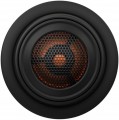Size
The size of the speakers of the acoustic system; in speakers with different driver sizes (component and coaxial, see "Type"), the size is determined by the diameter of the largest (woofer) driver. The size of the speaker determines primarily its ability to work with low frequencies. It is believed that acoustics up to 4 "is practically not suitable for low frequencies (regardless of the frequency range), 5-6" refers to the average level, and speakers of
6" or more even allow you to do without a subwoofer. Also, the size affects the installation options. So , some cars may provide seats for acoustics of a certain size — this limits the choice.And for large acoustics, there may not always be a place in cars with cramped interiors.
Rated power
Rated power of the acoustic system. Most often, the average (root mean square) sound power is indicated as rated.
The most obvious point related to this characteristic is the volume of sound: the more powerful the sound system, the louder the sound it can produce, all other things being equal. In addition, compatibility with an external amplifier depends on this indicator: its power should not exceed the power of the sound system, otherwise overloads and damage to the speakers are possible.
Max. power
The maximum power of a short-term (up to several seconds) incoming signal that the speaker can withstand without physical damage. Just like the nominal power, it matters for the selection of acoustics for an amplifier (or vice versa): it is believed that the maximum power of the speakers should be at least 2 times higher than the maximum power of the signal source.
Frequency range
The total audio frequency range reproduced by all speaker speakers.
Obviously, this range should not be too narrow, so that the acoustics do not cut off the lower and/or upper frequency limits of the reproduced sound. At the same time, the human ear perceives sound within 16 Hz - 22 kHz, and it simply does not make sense to provide speakers with a wider frequency range. We also recall that in
mid-frequency acoustics and tweeters, reproducible frequencies are limited due to specialization (for more details, see "Type"). And the overall sound quality will depend not only on this indicator, but also on a number of other features.
Impedance
The term "impedance" refers to the electrical resistance of AC systems whose DC resistance is very low, such as loudspeakers. In modern car audio, the most common impedance is
2,
4 or
8 ohms. This parameter has practically no effect on the sound quality — it serves to select the optimal combination of acoustics and an external amplifier. If the speaker impedance is higher than that for which the amplifier is designed, the sound will be quieter than necessary, and if the impedance is lower, distortion in the sound is possible.
Sensitivity
This parameter determines the volume of the sound of a particular speaker when a certain standard signal is fed to it. Typically, this is considered a 1 W signal with a frequency of 1000 Hz. The higher the sensitivity, the less the speaker is demanding on the power of the amplifier. So, it is believed that for acoustics connected directly to the car radio, the sensitivity should be 80 dB or more; for less sensitive systems it is recommended to use a separate amplifier.
External crossover
Crossover is part of acoustic system that divides the overall signal into separate frequency bands fed to the corresponding speakers (for more details, see "Bands"). All multi-band speakers (component and coaxial, see "Type") have their own crossover; it is usually located directly in the speaker body. However, in some models, usually the most advanced ones, the crossover can be made as a separate device, in its own body.
External crossovers are considered to provide better sound quality and introduce less distortion into it; in addition, they often provide the ability to fine-tune the sound.
Tweeter size
Size of the high-frequency speaker(s) included in the speaker design.
Size affects the amount of space required to install the speaker. However, high frequencies do not require large diffusers, so this dimensions is usually small and does not significantly affect the overall dimensions of the speaker system. The only exception is individual high-frequency tweeters (see "Type"), where the overall dimensions of the housing are directly related to the dimensions of the diffuser.

